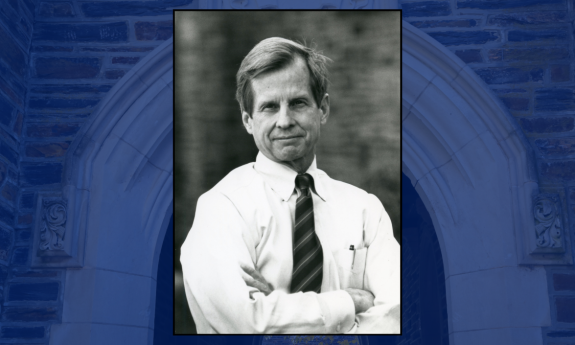[Updated with Memorials]: Long-time Student Affairs Administrator Bill Griffith Dies at Age 98

“Today, Duke students experience daily the profound impact of Bill Griffith’s vision and investment in this campus and our student community,” said Mary Pat McMahon, vice president and vice provost for student affairs.
“His decades at Duke were marked by a commitment to innovative student leadership, the arts, and so much more. Today, whether students are in class, performing in Griffith Theater, participating in immersive, student-driven events like Experiential Orientation, or involved in DUU (Duke University Union) or DSG (Duke Student Government), they are walking in Bill's footsteps.”
Larry Moneta, who served as vice president of student affairs from 2001 to 2019, said Griffith’s legacy was one reason he was attracted to Duke. Griffith, he said, was a national figure who influenced the student affairs profession across the country.
“Bill was my mentor and a mentor to many in the student affairs profession,” Moneta said. “I took the job at Duke partially because of Bill’s legacy and reputation. His tenure at Duke was remarkable in numerous ways and his care and advocacy for students ensured the success of thousands of alumni who will always remember him as a gentle giant with students’ best interests always in mind.
“Duke’s leadership in the arts, with student diversity and with student leadership development can all be traced back to Bill Griffith’s extraordinary efforts.”
Griffith played a key role in the launch of Duke Student Union and in helping shape Duke Student Government, Project WILD, the Community Service Center, the Women’s Center, the Black Student Alliance, the Career Development Center, Counseling and Psychological Services, the Publications Board, and many other successful endeavors at Duke.
Griffith is also credited with boosting the arts at Duke, including helping create the Duke Artists Series and the National Association of College and University Concert Managers, a national organization for college arts administrators.
Perhaps his most publicized role in administration-student relations came in 1969, when Griffith was dean of student affairs, and Black students, upset with the lack of responsiveness from the administration on providing higher wages for workers, occupied the first floor of the Allen Building. The students were also calling for a Black cultural center, a curriculum in African-American studies, and other issues. Griffith helped mediate during that tense event, and he recalled that experience in 2013, the 50th anniversary of Duke’s integrated student body.
“I recognized why the students were doing it,” he said. “The Black students wanted better treatment from the administration. I felt that the Duke situation with the vigil was different from what was going on at other campuses. It was never physically destructive. It was rather unique. I actually got calls from news services, who would say, ‘Call us if it gets rough.’
“I give credit to the students. That was just the way they did it.”
Griffith’s legacy continues at Duke. The William and Carol Griffith Theater in the Bryan Center is named for Griffith and his wife, and the William J. and Carol T. Griffith Endowment has supported a variety of student programs, including The Center for Race Relations, the Graduate and Professional Student Council, Springternational, the Arts Theme House and the Duke Photo Group.
In 1992, an award was renamed the William J. Griffith University Service Award, which recognizes graduating students for their significant contributions to Duke and the larger community.
Throughout the more than four decades in which Griffith was connected to Duke, he made a priority of supporting the faculty, staff, students and alumni who he believed were the strength of the university. “The whole university becomes a better place, becomes a greater university because of all of you—students, faculty, administrators,” Griffith said after retiring from Duke. “I'm going to stay around for a long time. I've got to see what's going to happen next.”
After retiring, Griffith spent years cultivating the arts on campus through his work with the Nasher Museum of Art. He also founded and chaired Duke University Retiree Outreach to engage retirees with local service activities. In addition, he was known for his many years of success on the tennis court and his love of running.
Griffith’s parents were William J. Griffith Jr. and Ida Brown Mehard Griffith. He was born in Pittsburgh, Pa., on June 8, 1926. Griffith is survived by his wife, Carol (’52); his two daughters, Trena Griffith-Hawkins (Richard Hawkins) and Brown Griffith Little (Mark Little); and granddaughters Cameron Hawkins Gambrell (Tony Gambrell), Carol Rose Little and Grace Little.
A private family remembrance is planned. Memorials may be made to the William J. and Carol T. Griffith Endowment or to Duke University Chapel or to the charity of your choice.